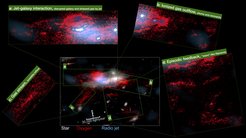JWST's sharp view unveils intricate details in galaxies' gas halo
Galaxies are surrounded by a large reservoir of gas called the circumgalactic medium (CGM), where they refuel and recycle the gas for forming stars and growing in mass. This gas is extremely dim, with current observations being limited to spectral lines that are hard to interpret. It is therefore challenging to understand the mass, distribution, and physical conditions prevalent in the CGM. Recently, a group of researchers at MPA serendipitously discovered bright oxygen emission around a massive galaxy group in the distant universe using the James Webb Space Telescope (JWST). In collaboration with other international scientists and by combining various observations, the study provides a detailed and unprecedented view of the CGM, showing how galaxies influence the gas and their environment.

The well-known galaxy group SMM J02399-0136 includes a galaxy dominated by an active supermassive black hole, a dusty galaxy forming stars at very high rates, which is colliding with the quasar, and an irregular satellite galaxy (see Fig. 1). It is located at redshift 2.8 (when the universe was about 2.3 Gyr) and the galaxies appear gravitationally lensed in an east-west direction. Initially discovered due to its high star formation activity, later studies suggested a large reservoir of cool gas in atomic or molecular form in its CGM.
The new JWST observations offer the sharpest and one of the deepest views of the CGM gas. In particular there is strong oxygen emission ([O III]λ4959,5007Å), which extends at least 100 kpc (300,000 light-years) across its CGM. The oxygen distribution matches well with the hydrogen distribution revealed by previous Lyman alpha observations. Besides its vast extent, the image also uncovers a detailed filamentary structure of the CGM gas, resolved only by JWST (see zoomed images in Fig. 2).
The emission line of doubly ionized oxygen provides critical information. The bright emission indicates the presence of denser and warmer gas in the CGM than previously expected. Each of these long and narrow filaments contains a substantial gas mass, about a billion times the mass of the Sun, all in ionized form. Additionally, the large quantities of oxygen—produced only in stars and supernovae—compared to hydrogen in the CGM suggest that the CGM is chemically enriched by gas ejected from galaxies.

(a) Enlarged image of the disrupted satellite galaxy to the left of the quasar. The relativistic jet from the quasar (in blue) disrupts and strips the gas. The brightened region indicates where the jet interacts with the gas in the galaxy, whereas gas previously blown away from the satellite galaxy is seen as filaments further out.
(b) A strong plume-like feature indicates a strong outflow from the quasar, and patchy remnant of previous outflows extends far to the right.
(c) A long gas stream with a possible origin of inflow.
(d) The "wave"-like structure, consisting of three parallel stripes, suggests episodic black hole activities and their feedback effects in the past.
The bright filaments significantly contrast the "nebula" picture from previous studies. The high-resolution images show that the gas in the CGM is not distributed more or less uniformly, but rather resides in long and narrow filaments. The morphology, distribution, and oxygen abundance all point to past feedback from galaxy activities, which have fed mass, energy, and heavy elements into the CGM gas. Furthermore, the interaction between the quasar jet and the neighbouring galaxy is a striking example of how massive galaxies can impact their environments. These high-resolution images also challenge numerical simulations, which need to explain and reproduce the exquisitely complex structures revealed in this galaxy group.
The study demonstrates how CGM research can leverage the unprecedented resolution and sensitivity of the JWST, as well as the usefulness of oxygen lines in interpreting the gas's physical conditions. The research group is currently working on additional multi-wavelength data to construct a comprehensive understanding of various forms of gas in the CGM.













